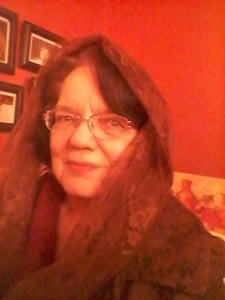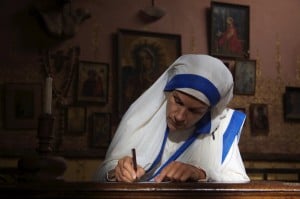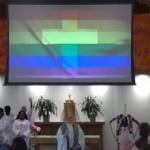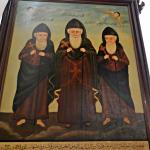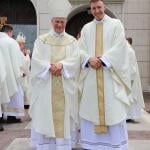On Saturday, October 11, the Diocese of St. Augustine will honor Mary in her role as a new mother nursing her infant.
Bishop Felipe J. Estévez, head of the northeastern Florida diocese which is the oldest diocese in the United States, has declared the Feast of Our Lady of La Leche to be celebrated throughout the diocese.
He also instituted a Jubilee Year in commemoration of the Blessed Mother, celebrating the 450th anniversary of the founding of America’s oldest city at the site of the current shrine.
The chapel sits on what is sometimes called “America’s most sacred acre,” a peaceful parcel of land overlooking an inlet of the Atlantic Ocean. The diocesan website explains the importance of the site:
At this site, the first documented parish Mass in America took place (with four celebrants, the main one Father Francisco López de Mendoza Grajales) as a prominent explorer who they accompanied, Admiral Pedro Menéndez de Avilés, from Cadiz, Spain, and his fleet of ships made landing, kissing a Cross. The Mass was one of thanksgiving — opening a claim that this was America’s first thanksgiving day (it too involved a feast and Indians).
“The historical record tells us that the action of kissing the Cross and the celebration of the first Mass in what is now the City of Saint Augustine, Florida, permanently planted the Christian Faith in the land that is now the United States of America,” said Bishop Estévez in making the declaration.
The spot of the Mass is marked today with a 208-foot Cross that’s believed to be the world’s tallest. Recent archaeological digs by the University of Florida have unearthed the original pole-and-palm-roof chapel. It is the first parish in the U.S. — so old it was originally under the diocese of Havana, Cuba (and later Savannah, Georgia).
The shrine is often visited by women who seek to have a child, are having problems with pregnancy, or simply pray for a healthy birth and family. Many claim miraculous interventions. The full name for Mary here is “Nuestra Señora de la Leche y Buen Parto – Our Lady of the Milk and Happy Deliver.” The site was originally called “Nombre de Dios” — the Name of God, itself a sign perhaps of our time, as devotions to God the Father are increasingly under discussion, after centuries of neglect: unearthed as now this holy spot unearths the founding, at a climactic time, of American Catholicism.
* * * * *
The History of the Shrine

On September 8, 1565, Admiral Pedro Menendez de Aviles landed with a band of settlers on the shore of what is now Florida, where he established the city of St. Augustine. A formal Franciscan mission–perhaps the first mission in the continental United States–was founded near the city in 1587. The Mission Nombre de Dios (Mission of the Name of God) served nearby villages of the Mocama tribe, a Timucua group, and was at the center of an important chiefdom in the late 16th and 17th centuries.
At the Mission, resident Spanish colonists were served by missionaries–first Jesuits, then later Franciscans. The missionaries also attempted to evangelize the local Mocama and Agua Dulce peoples near St. Augustine, converting the chief and his daughter.
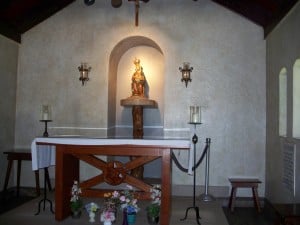
In the 1670s, the Spanish governor of Florida ordered a church to be erected on a site adjacent to the Castillo de San Marcos, a fortress which was under construction. The church was completed in 1677, and was dedicated to Nuestra Senora de la Leche y Buen Parto–which means “Our Lady of the Milk and Happy Delivery.”
Today, the faithful and the curious visit this church, a quiet spot for prayer and reflection. Some make a pilgrimage to pray before the statue of Our Lady of La Leche, lighting candles and scrolling prayers for a couple just beginning married life, for the gift of a child, or for a healthy pregnancy and a safe delivery.
I told the story of the Mission, and my visit to the Shrine last summer, here.
* * * * *
Origin of the Devotion
Devotion to Our Lady of La Leche (Our Lady of the Milk) dates back to the Holy Land, where the Milk Grotto is a popular devotional site.
According to tradition, the Holy Family took refuge in the Milk Grotto during Herod’s Slaughter of the Innocents, before their flight into Egypt. There in the grotto, Mary nursed the newborn Jesus; and while she was nursing, a drop of milk fell to the ground—immediately turning the rock white.
The grotto has been a holy site for both Christians and Muslims, who believe that scrapings from the soft white stones in the grotto can boost the quantity of a mother’s milk and enhance fertility. The custom is for nursing mothers to mix the shavings into their drinking water. Expectant mothers place the rock shavings under their mattress.
Learn more about the Milk Grotto here.



